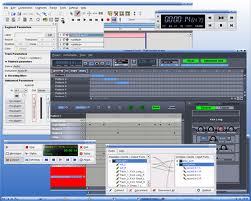 Mi sono imbattuto per caso in quella che considero una delle guide alla creazione audio più complete per Linux, e Stefano mi ha dato il permesso di ripubblicare il suo materiale che considero ottimo e che lui utilizza in quanto musicista.
Mi sono imbattuto per caso in quella che considero una delle guide alla creazione audio più complete per Linux, e Stefano mi ha dato il permesso di ripubblicare il suo materiale che considero ottimo e che lui utilizza in quanto musicista.
Stefano è un utente di Ubuntu e la sua guida si basa su questa distribuzione, è molto attivo nella comunità italiana di Ubuntu, se volete fargli una domanda riguardante la sua guida, è possibile postarla in questo thread http://forum.ubuntu-it.org/index.php/topic,278719.0.html.
Potete trovare la parte 1 di questo tutorial qua mentre trovate la parte numero 2 qua
Questa è la parte numero 3, ho intenzione di ripubblicarel’ultima parte nei prossimi giorni.
11. Ardour, Rosegarden, Hydrogen
Il cuore di tutto è Jack, dicevo. Ma gli organi vitali sono ovviamente la drum machine (Hydrogen), il sequencer MIDI (Rosegarden) e il registratore audio multitraccia (Ardour).
Carichiamoli tutti e tre, dopo aver avviato ovviamente Jack.
In ognuno andremo a scegliere Jack come trasporto, in modo che i tre programmi vadano insieme, come se fossero un unico programma.
Ardour: In alto a destra vicino al timer, sopra a “Time Master”, selezionate “Jack”
Rosegarden: Impostazioni → “Configura Rosegarden…” → Generale → Comportamento. Spuntare la casella “Usa il trasporto Jack”.
Hydrogen: File → Preferenze → Sistema audio. Alla voce “Driver audio” scegliere “Jack”.
Premendo play in qualsiasi programma, gli altri due partono.
Ricordatevi di cambiare il metronomo in tutti e tre i programmi, in quanto la sincronizzazione avviene solo per il play/stop/pause, non per tutto il resto.
A questo punto non resta che studiare i programmi che usiamo.
Per Rosegarden: http://www.rosegardenmusic.com/resources/
Per Ardour: http://www.wguitars.it/ardour.php. Un altro splendido manuale (in inglese) che vi porta per mano nella costruzione di una canzone intera, coprendo tutte le funzionalità di Ardour, si trova qui:http://en.flossmanuals.net/ardour/
Per Hydrogen: http://www.hydrogen-music.org/?p=docs
Infine, se non usate Ardour, a questo punto potete anche premere su “Connect” in Jack e divertirvi a collegare gli strumenti. Lo potete fare anche se usate Ardour ma, avendo Ardour una gestione interna di Jack, potete farlo da lì (è più veloce) e visualizzare graficamente quello che avete fatto premendo “Connect” su Jack.
Io in questo esempio bizzarro ho collegato il microfono (Capture in alsa_pcm) a Jack Rack, cioè in sostanza ho detto di collegare la presa della mia scheda sonora (a cui è collegata la mia chitarra elettrica) all’ingresso di Jack Rack, dove c’è una serie di distorsioni, poi ho collegato l’uscita di Jack Rack all’ingresso di registrazione di Rosegarden e alle casse (per sentire in diretta cosa sto suonando). Inoltre ho anche connesso Qsynth alle casse (così sento i suoni delle tracce midi) e ovviamente l’uscita di Rosegarden alle casse per sentire il risultato finale. È solo un esempio, potevo fare tante altre cose: potevo mandare l’uscita record monitor di Rosegarden alle casse invece dell’uscita di Jack Rack, potevo far entrare nella scheda sonora l’uscita del mio Korg e collegarla direttamente alle casse o alla registrazione di Rosegarden per trasformare in file sonoro la base MIDI, eccetera eccetera. Le combinazioni sono infinite e sono tutte da provare.
12. Arrangiare con gmorgan
Gmorgan ci permette di testare la nostra canzone prima di costruire la base da zero. Assomiglia, in piccolo, a Band in a Box (che però è a pagamento, per Windows, ma funziona anche su Ubuntu grazie a wine, vedi appendice B). Ossia ha due funzioni:
– decidiamo lo stile (jazz, country, dance, quello che volete), colleghiamo una tastiera MIDI al computer, e mentre con la sinistra suoniamo solo gli accordi, con la mano destra suoniamo lo strumento solista. Gmorgan cambia al volo gli accordi degli altri strumenti: chitarra, basso, piano…
– per ogni battuta della canzone, gli diciamo con quale stile e quale accordo fare. Gli diciamo anche dove ripetere, quando ripetere, quando fare una variazione (per esempio un break o un fill, o un finale, o un’intro) e lui la esegue diligentemente. Se ci piace, la esportiamo come MIDI.
12.1 – Configurazione
La prima che si avvia gmorgan, occorre dirgli un po’ di cose, altrimenti non funziona.
Avviatelo e andate su Settings → Global. Otterrete una schermata che va configurata così:
(se non vedete bene, cliccandoci su la renderete più grande).
Lì dove vedete selezionato “Timidity 0”, potete ovviamente scegliere quello che volete: QSynth, un rack esterno, la wavetable…
Premete “Save” e riavviate gmorgan.
12.2 – Uso
A questo punto vi si presenterà questa schermata:
Selezionate dall’elenco a destra lo stile che volete (a sinistra ci sono le variazioni di quello stile) e premete “Start/Stop”. Sentirete l’orchestrina che comincia a suonare. Se siete collegati con una tastiera MIDI, ora potete fare un accordo con la mano sinistra, e magicamente gmorgan sposterà la tonalità della canzone su quell’accordo, e tutti gli strumenti verranno dietro. Con la destra intanto potete sbizzarrirvi in un assolo. Ed è subito piano bar! ^_^
Ora che vi siete divertiti e avete trovato lo stile giusto per la vostra canzone, fermate premendo su “Start/Stop” e premete, nel menu, “Sequencer”. Lì potete mettere gli accordi (ogni quadratino è un quarto della battuta) e lo stile (il numero in alto a destra di ogni battuta corrisponde a uno stile, il cui elenco è in basso a sinistra). Potete anche dirgli anche dove ripetere e dove tornare indietro, e dove terminare. Se non scrivete nulla fa l’accordo e lo stile precedente. Premete “Start/Stop” per ascoltare la vostra creazione. Si capisce meglio con un esempio:
Qui trovate istruzioni molto più dettagliate: http://gmorgan.sourceforge.net/doc.html
In particolare, per quanto riguarda il sequencer: http://gmorgan.sourceforge.net/doc.html#III.H%20-The%20Sequencer%20Song|outline
Ultimata la bozza della canzone, la esportate andando, nella finestra del sequencer, su “File” → “Export MIDI file”. A questo punto potete importarla in Rosegarden per modificarla come si deve, per renderla più bella e più varia, per adattarla alle vostre esigenze.
13. Produrre la nostra canzone
Ora che abbiamo configurato Rosegarden, Ardour e Hydrogen e sappiamo come importare ed esportare, possiamo cominciare a registrare la nostra canzone.
Apriamo quindi, in quest’ordine:
– Jack Control. Premete Start e assicuratevi che sia attivo.
– QSynth. Controllate che i soundfont siano caricati. Disattivate chorus e riverbero.
– Eventualmente potete caricare altri QSynth con altri soundfont, memoria permettendo.
– Hydrogen
– Rosegarden
– Ardour
13.1 – Impostazione del progetto
Prima di tutto è necessario fissare il metro e il tempo della canzone, altrimenti i software andranno per conto loro senza sincronia.
Rosegarden:
– Posizionatevi all’inizio della canzone e premete: “Composizione” → “Apri l’editor di tempo e di metro”.
– Doppio click sulla riga “Ritmo”. Cambiatelo a vostro piacimento. Lo stesso per il tempo. Sarà sempre possibile cambiarli in futuro, e variarli in successivi eventuali cambi di metronomo all’interno del brano.
Ardour:
– Sopra la traccia “master”, se ci fate caso, ci sono parecchie righe: Timecode, Meter, Tempo…
– Cliccando col destro su “4/4” e scegliete “Modifica”: potrete variarlo a vostro piacimento.
– Lo stesso per il metronomo.
Hydrogen:
Il metronomo di Hydrogen è in bella vista nel player, basta cliccarci sopra.
A questo punto la cosa migliore è comporre una piccola base di batteria con Hydrogen. Basta un tempo base, che andrete a modificare man mano che la canzone procederà.
Per usare al meglio Hydrogen, leggete bene la guida e il tutorial.
13.2 – Impostare gli strumenti musicali
Su Rosegarden:
– Se volete usare solo i soundfont, vedete il paragrafo 13.3. Se volete collegare più macchine MIDI, procedete con la lettura di queste istruzioni:
– “Studio” → “Gestisci dispositivi MIDI”.
– Premendo il menu a tendina nella colonna “Connessione” in corrispondenza di “General MIDI device” vedrete un po’ tutti gli strumenti di cui disponete.
– Se per esempio avete un modulo esterno collegato via MIDI a una SoundBlaster, imposterete l’uscita su “Emu10k1 MPU-401”. Se avete Timidity, lo imposterete su Timidity. Se avete precaricato nella SoundBlaster Creative i soundfont tramite asfxload, imposterete “Emu10k1 Port 0”. Se usate i soundfont con QSynth, imposterete “Synth input port”.
– Potete anche scegliere più di uno strumento, usando i successivi “out 2”, “out 3” e via dicendo, cambiando loro nome.
– Come dispositivo di registrazione, se non digitate a mano le note MIDI ma vi aiutate con una tastiera esterna collegata via MIDI, sceglierete MPU-401. Se usate “Virtual MIDI keyboard” (lo trovate nei repository) imposterete quello.
– Se avete un modulo esterno (rack o tastiera che sia) che vi fa da orchestra MIDI, sotto “Dispositivi di riproduzione” selezionate quel dispositivo e premete “banchi”. Nell’elenco, selezionate quel dispositivo e premete “Importazione in corso”. Se c’è nella lista, avete anche tutto l’elenco degli strumenti della vostra tastiera.
Ecco un altro esempio:
Come vedete, in questo esempio fra i vari output ho due dispositivi (o “macchine MIDI”) che uso:
1) “General MIDI device” collegato al dispositivo QSynth
2) “MIDI software device 2” collegato al dispositivo Timidity
E tra gli INPUT ho:
1) “MIDI hardware input device” collegato alla presa del cavo MIDI IN, che da me si chiama “EMU10K1 MPU-401” ma da voi non so come si chiama perché dipende dalla vostra scheda MIDI.
2) C’è anche la possibilità di avere un ingresso software (per esempio una tastiera virtuale disegnata sullo schermo) che però nell’esempio non ho attivato.
13.3 – Assegnare più istanze di QSynth
Se avete più istanze di QSynth (vedi paragrafo 7.2), vi farò un esempio in cui ho caricato tre istanze di QSynth, ognuna con dei soundfont diversi:
QSynth1 → FluidR3_GM.sf2
QSynth2 → PC51f.sf2
QSynth3 → steinbow_mg.SF2 (ottimo soundfont di pianoforte con soli quattro strumenti)
Cambiate il nome e/o aggiungete dispositivi di riproduzione, assegnando un nome corrispondente all’output giusto, così:
– Premete su “Banchi…”
– Andate su FluidR3_GM e premete su “Importazione in corso…”
– Nel percorso selezionate /usr/share/sounds/sf2
– Nel “Files of type” selezionate “Fonti di suono (*.sf2 *.SF2)”
– Dall’elenco scegliete FluidR3_GM.sf2 e quindi Open, e infine OK
– Fatelo anche per PC51f e per Steinbow, con i relativi soundfont
Dovreste avere ora una schermata simile:
Chiudete e andate nella finestra principale di Rosegarden.
A ogni traccia date il nome del soundfont e dello strumento, così da ricordarvi, Nel prossimo paragrafo vediamo come assegnare gli strumenti alle tracce.
13.4 – Assegnazione dei dispositivi e degli strumenti MIDI
Sempre su Rosegarden, assegniamo ora gli strumenti:
– click col destro sui vari “Senza titolo” → scegliete il dispositivo e il canale MIDI di quella traccia
– in basso a sinistra su “Parametri dello strumento” scegliete eventualmente il banco ma soprattutto lo strumento.
– per usare un sintetizzatore DSSI (per esempio Hexter, che è un emulatore di Yamaha DX-7), basta scegliere come dispositivo “Modulo del sintetizzatore”. Sotto “Modulo” potete scegliere quello che volete.
– a sinistra, nella finestrona principale di Rosegarden, su “Parametri dello strumento”, premete il primo “nessun modulo” per aggiungere eventuali effetti (e in cascata altri effetti sugli altri “nessun modulo”). Cliccando poi su Editor potete scegliere il preset che volete.
Tenete conto che potete avere a disposizione più dispositivi MIDI e che ogni dispositivo ha più strumenti, in genere un centinaio, o più di 100 ma divisi in banchi. Ogni dispositivo ha in genere al massimo 16 canali. A ogni canale si può assegnare un solo strumento.
Alcuni dispositivi sono hardware: sono collegati via USB o via MIDI e possono essere una tastiera sintetizzatore, un modulo Rack tipo Sound Canvas, eccetera. Altri sono software: QSynth, Timidity, la Wavetable della soundblaster, un modulo sonoro VST… Ognuno di loro ha probabilmente almeno un banco di suoni cosiddetti “GM”, ossia corrispondenti a uno standard che fa suonare “bene” le basi midi (un banco in cui al preset 1 c’è sempre il piano, al preset 2 c’è sempre il piano bright, e via discorrendo). Alcuni invece hanno solo un banco e uno strumento, sono in genere simulatori di un solo strumento, molto molto ben fatto, che occupa tutta la memoria che potrebbero occupare tutti gli altri strumenti insieme.
Per esempio:
Dispositivo: Korg X3
Canali: 16
Banchi: 2
Strumenti: Piano (banco 1, preset 1); Basso elettrico (banco 1, preset 12), Atmosphere (banco 2, preset 1) e altri 200. Il banco 1 è GM, l’altro banco è fatto di strumenti nuovi solo Korg.
Dispositivo: QSynth con soundfont PC51f
Canali: 16
Banchi: 1
Strumenti: tutti gli strumenti GM (1: Piano, 2: Piano bright, eccetera)
Dispositivo: QSynth2 con soundfont steinbow_mg.SF2
Canali: 1
Banchi: 1
Strumenti: Piano Stainway multicampionato (preset 1), Stainway piano bright (preset 2), Stainway piano saloon (preset 3), Stainway piano elettrico (preset 4)
Dispositivo: Timidity
Canali: 16
Banchi: 1
Strumenti: tutti i suoni GM
Dispositivo: Modulo del sintetizzatore
Canali: 24
Banchi: tutti i sintetizzatori che avete installato
Strumenti: un tot per ogni sintetizzatore.
eccetera.
Il bello è che possiamo assegnare a ogni traccia uno strumento scegliendolo tra i vari strumenti dei dispositivi collegati, e assegnargli un canale MIDI.
Vediamo un esempio pratico:.
Descrivo ora un esempio pratico: ci sembra che il basso di QSynth sia migliore. Quindi tasto destro, scegliamo QSynth e un canale a caso (cominciate dal primo. L’unica differenza: se è la batteria, per convenzione prendete sempre il canale 10), poi andiamo a sinistra su “Parametri dello strumento” e scegliamo il basso nel menu a tendina. Io per esempio ho un bellissimo suono di pianoforte nel Korg, nel banco di suoni non GM, quindi clicco col destro sul “Senza titolo” del pianoforte, seleziono il Korg, lo imposto sul primo canale, e poi a sinistra come banco scelgo il suo proprietario e come strumento scelgo “Piano 16”.
Naturalmente, se usate più strumenti della stessa macchina MIDI, le assegnerete più canali MIDI diversi. Per esempio: macchina Korg, basso sul canale 1, piano sul canale 2, e così via. Macchina QSynth, violini sul canale 1, sassofono sul canale 2, batteria sul canale 10. Occhio perché i canali MIDI sono in genere al massimo 16 per ogni macchina.
In realtà è molto meno complicato di quello che sembra. E oltretutto, vi fa finalmente capire l’utilità di “MIDI through”, sulla cui funzione vi siete – ne sono certo – interrogati per anni. 🙂
In questo esempio ho fatto click col tasto destro sulla prima traccia, a cui voglio assegnare lo strumento “Basso elettrico” del dispositivo QSynth. Quindi ho scelto prima il dispositivo “General MIDI device” (che, come avete visto nell’ultimo esempio prima di questo, è collegato a QSynth) e poi gli ho detto di usare come strumento il basso elettrico, che è il numero 34, sul canale MIDI #2 (come sapete, ogni dispositivo ha in genere 16 canali MIDI).
Poi vado con un altro strumento, per esempio il piano, ma lo voglio da Timidity e non da QSynth:
come vedete, ho cliccato col desto sulla traccia del pianoforte (la terza dall’alto), ho scelto come dispositivo “MIDI software device 2” (a cui è connesso Timidity, vedi sempre l’esempio di due schermate sopra) e come strumento il pianoforte, che è lo strumento #1. L’ho messo sul primo dei 16 canali disponibili.
Se poi ora cliccate sulla REGISTRAZIONE di una traccia (in ogni traccia ci sono due pallini: il secondo abilita la registrazione), senza premere veramente il record/play, abilitate il suono “in diretta”. Cioè, se selezionate la registrazione della prima traccia dell’esempio e avete una tastiera collegata via MIDI al PC, suonando con la tastiera sentirete il suono del basso di QSynth. Se invece abilitate la registrazione della terza traccia del mio esempio, suonando la vostra tastiera sentirete il suono del pianoforte di Timidity.
Tornando all’esempio del paragrafo 13.3, potremmo avere una cosa del genere:
Questa è la fine della parte 3 della guida su come produrre musica con Linux, restate sintonizzati per l’ultima parte
E grazie ancora una volta a Stefano Draghetti per questa guida.
[amazon_enhanced asin=”1886411344″ price=”All” background_color=”332610″ link_color=”FFFFFF” text_color=”D4CE99″ /]
[amazon_enhanced asin=”1593272707″ price=”All” background_color=”332610″ link_color=”FFFFFF” text_color=”D4CE99″ /]
Popular Posts:
- None Found

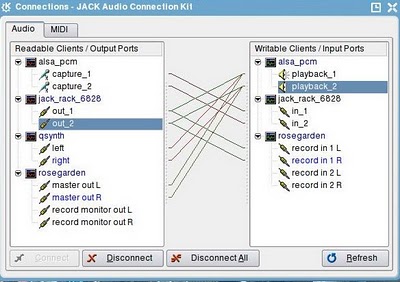
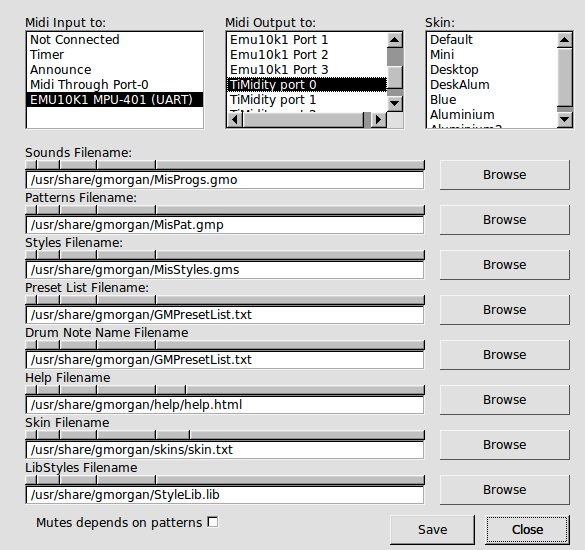
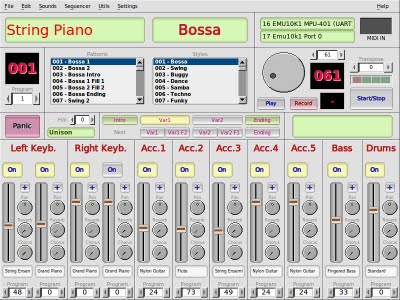
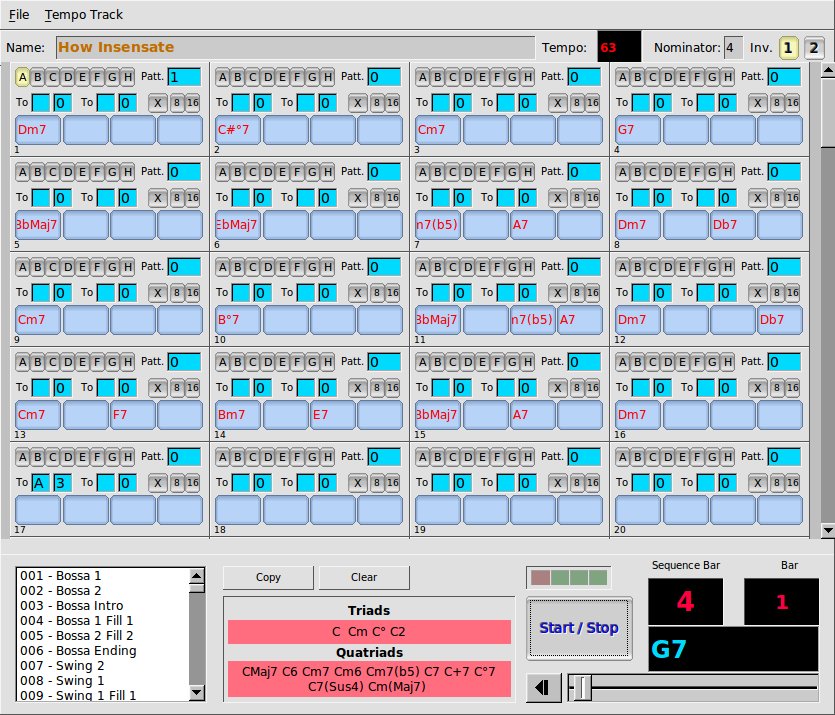
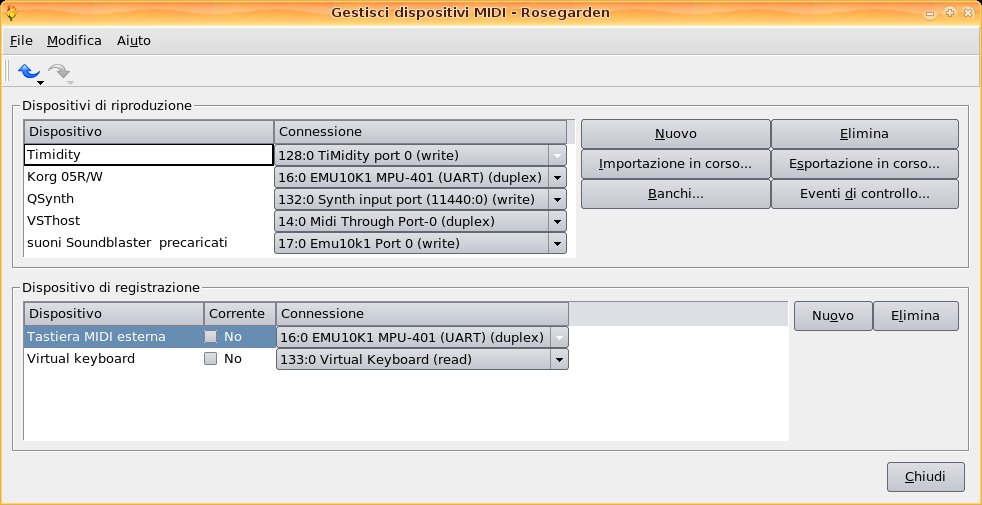
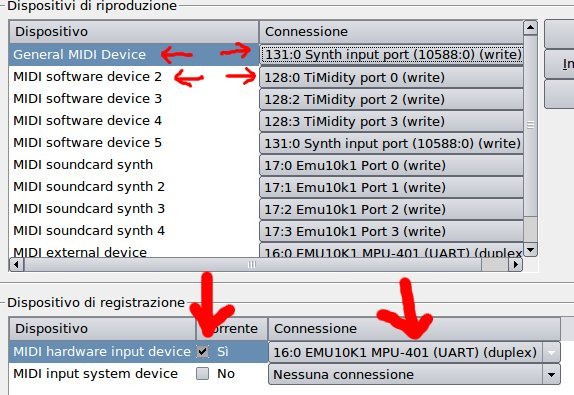
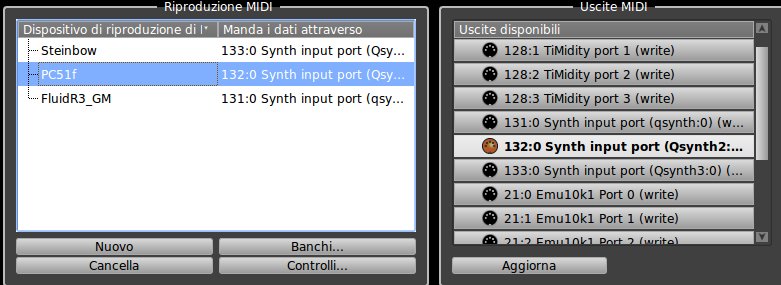
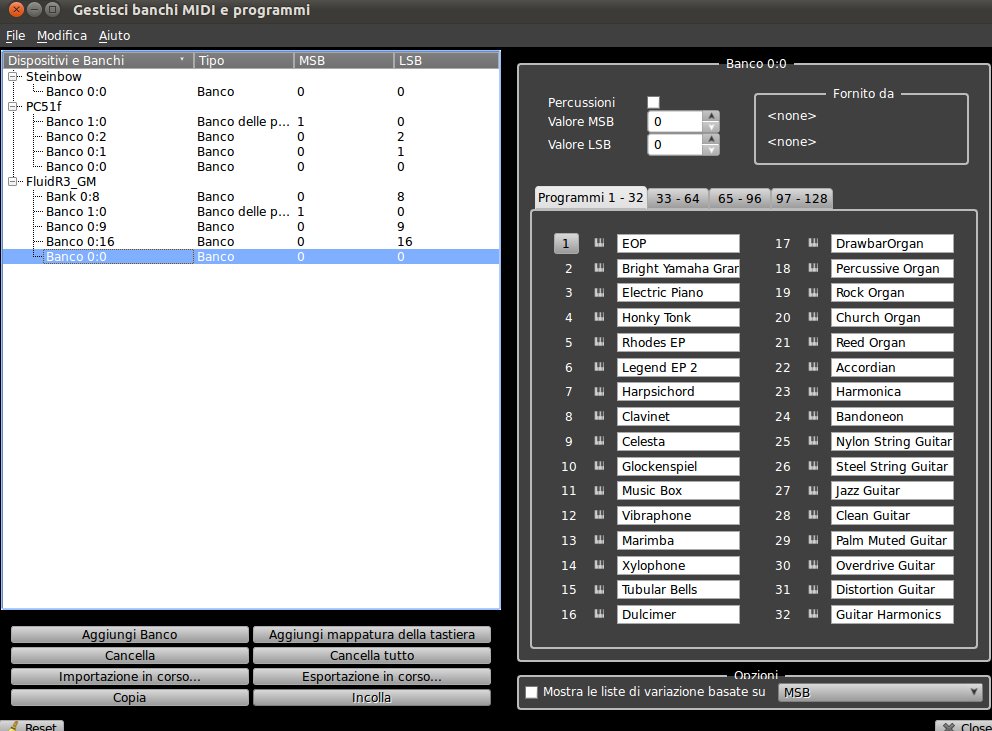


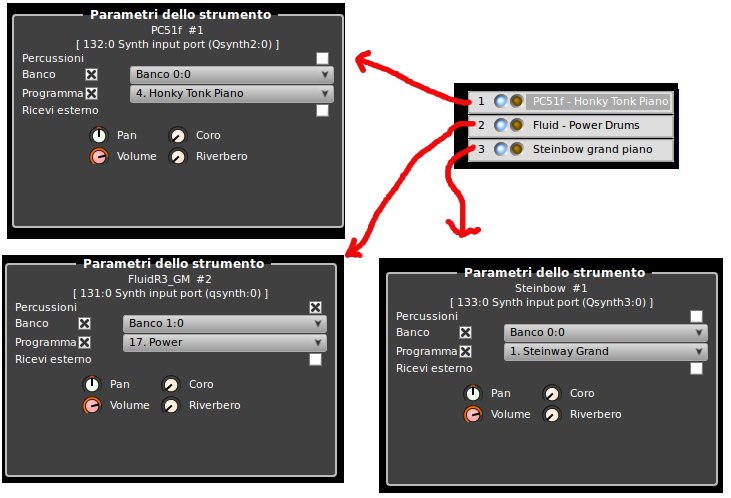

Thanks a lot! Very useful for noobs like me. Waiting impatiently for the last part. My gratitude to Stefano Droghetti, the author. He should write a book! Seriously, a lot of people would want to read it to begin making music on linux.